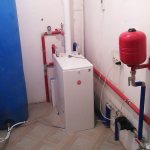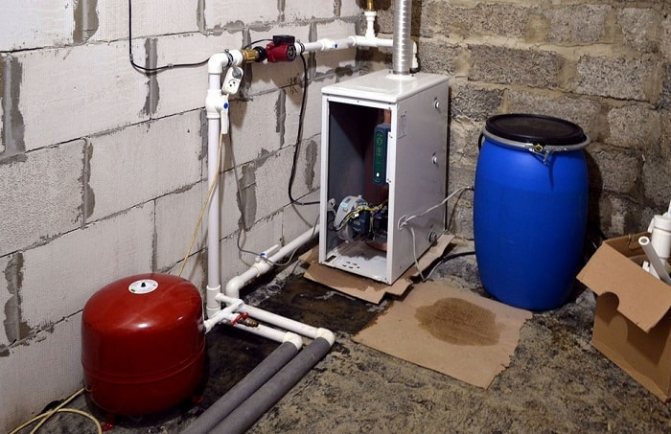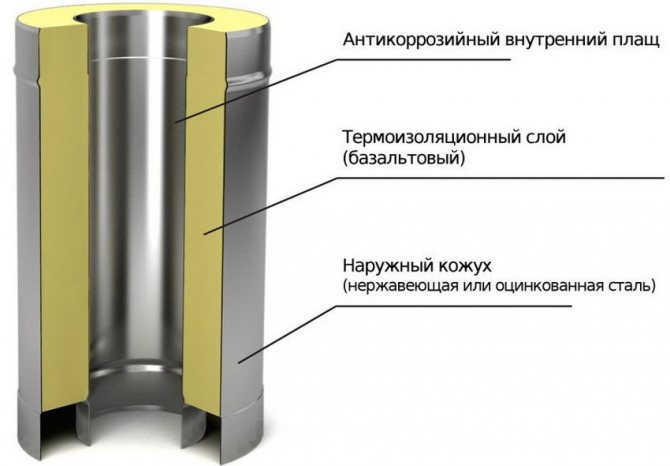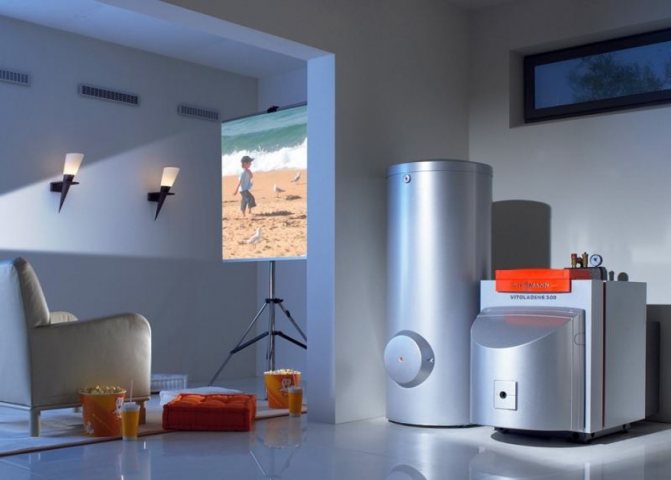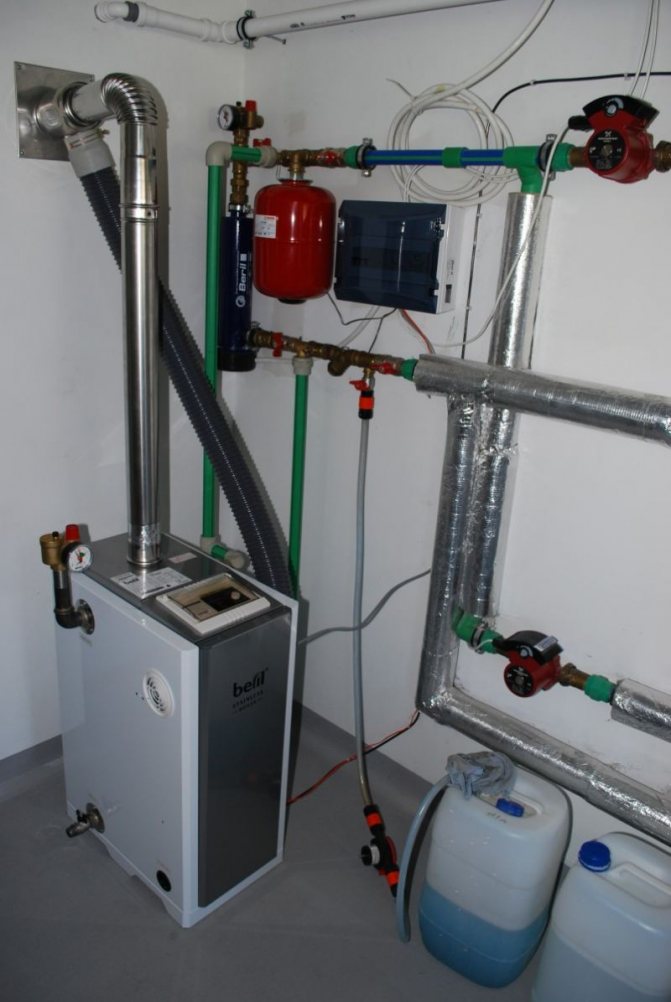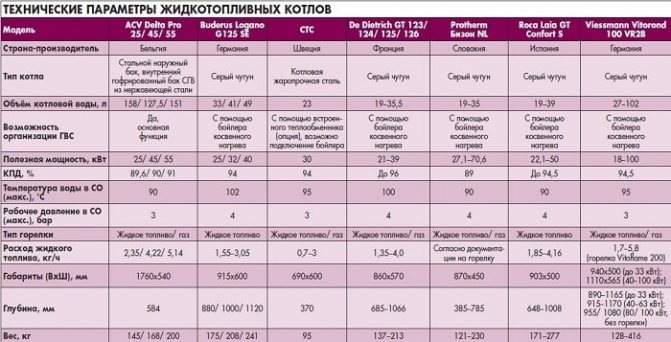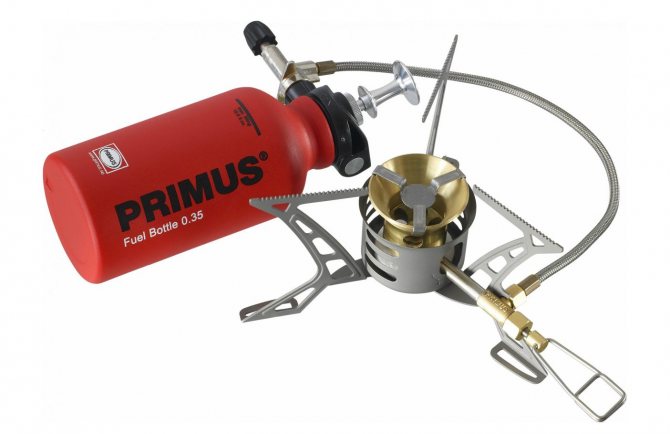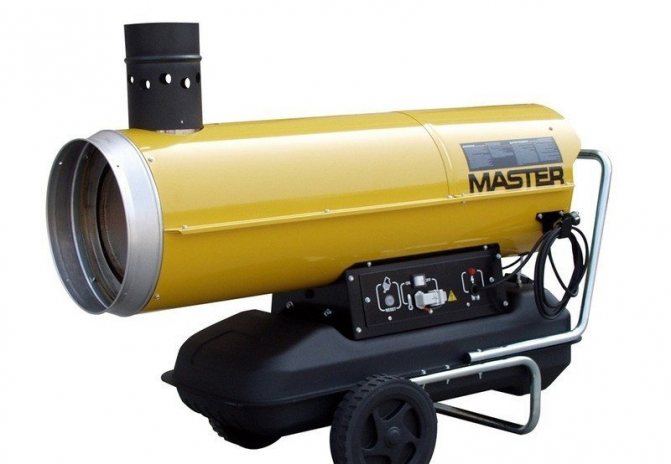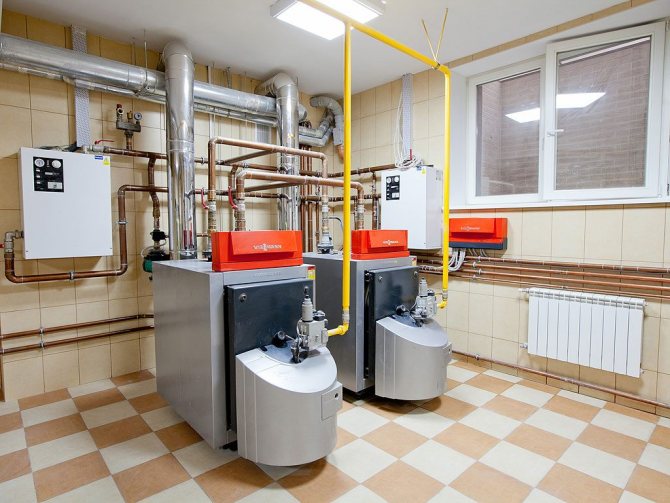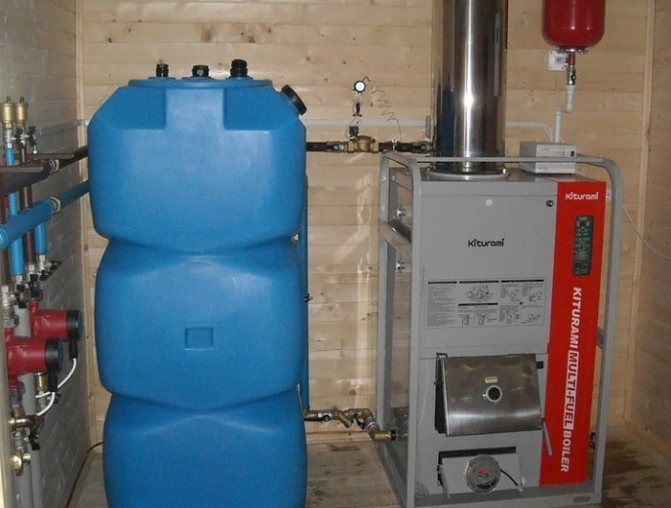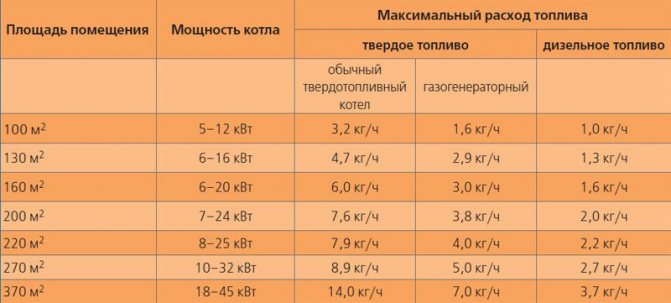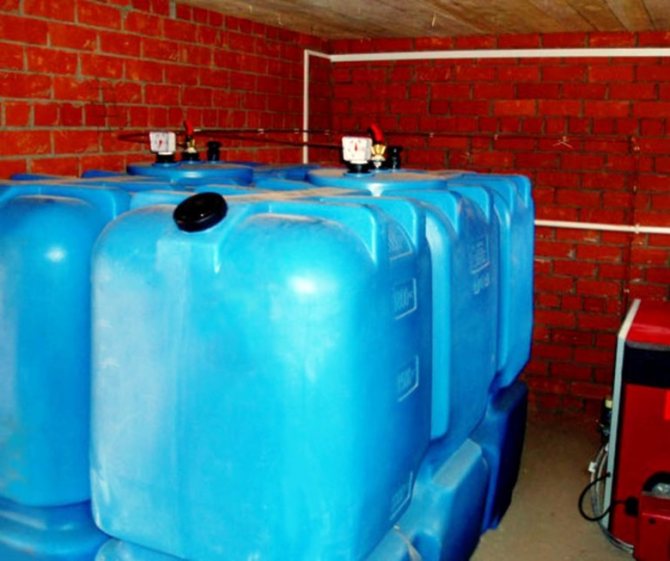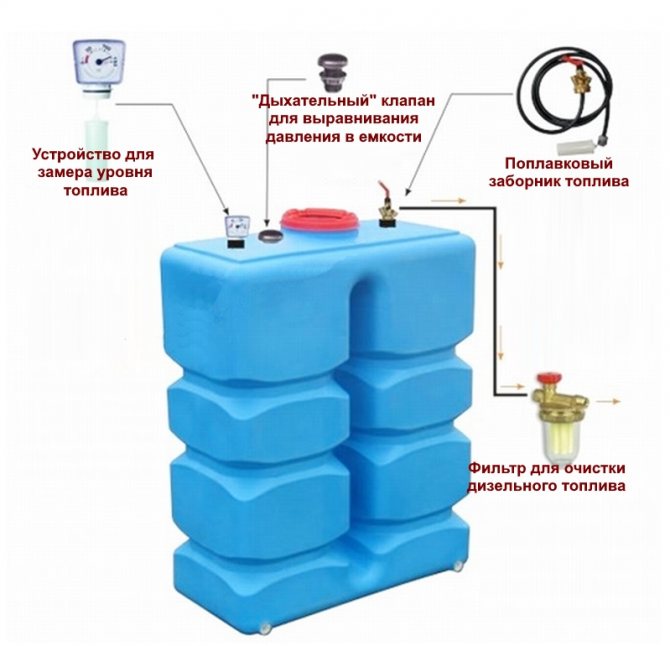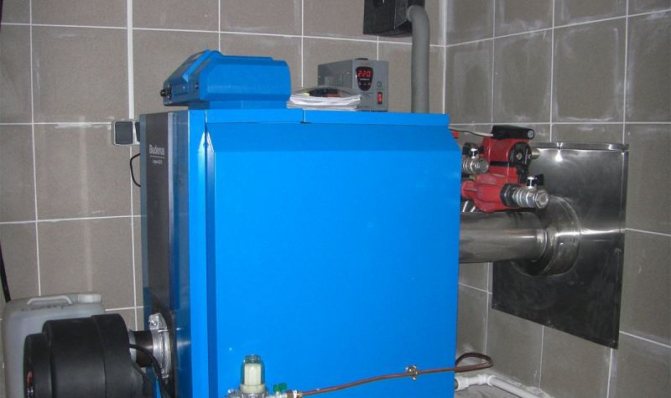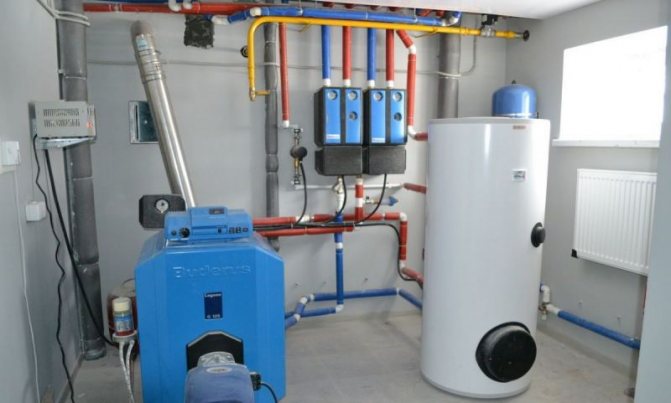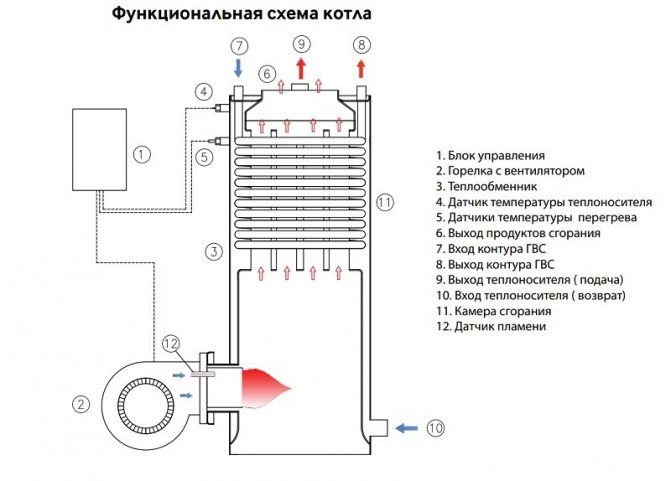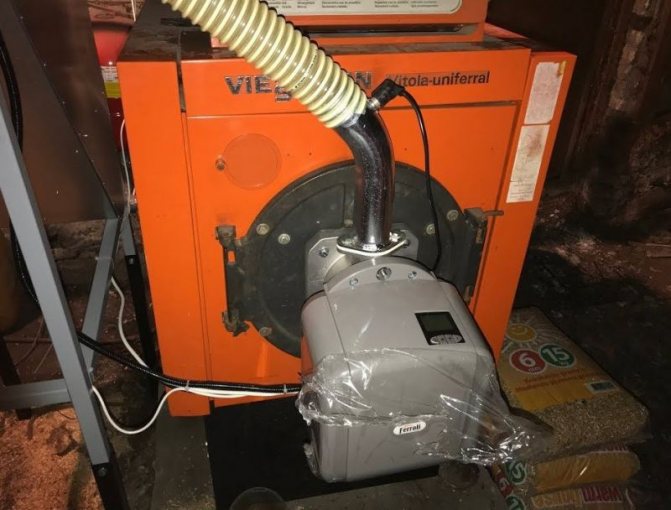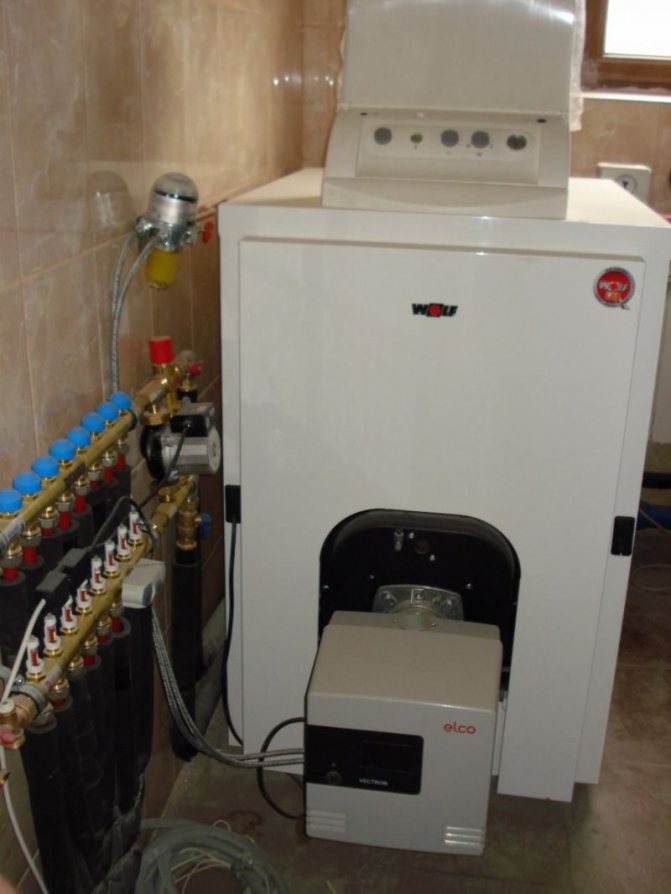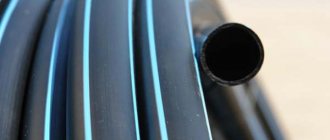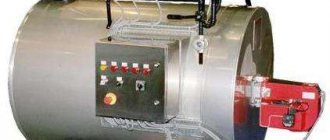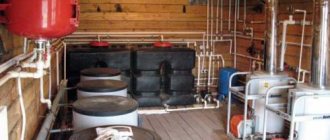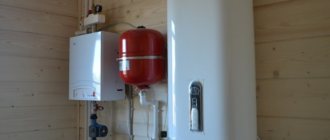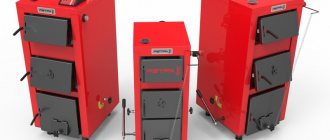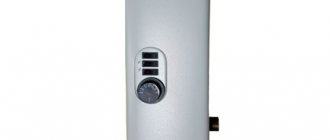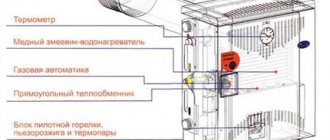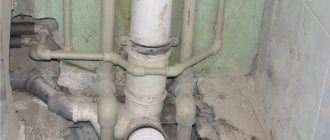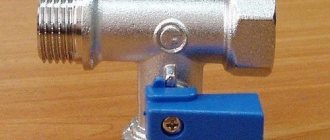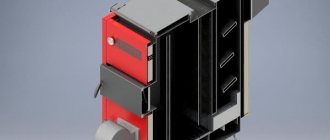Diesel fuel oil boilers occupy about 20% of the market. With a reliable power supply and regular maintenance, they are extremely reliable and durable. Diesel boilers, on average, have a higher efficiency than gas or solid-fuel ones, the efficiency is 90-96%, they do not require costly organization of a gas pipeline and paperwork, large rooms for storing fuel, after starting they are completely autonomous.
However, the high cost of diesel fuel is the reason for high operating costs: higher than gas and even solid fuel, but cheaper than electric boilers. High operating costs can often be offset by purchasing diesel fuel at wholesale prices or from local acquaintances.
What are diesel heating boilers
What are they for and how they are used
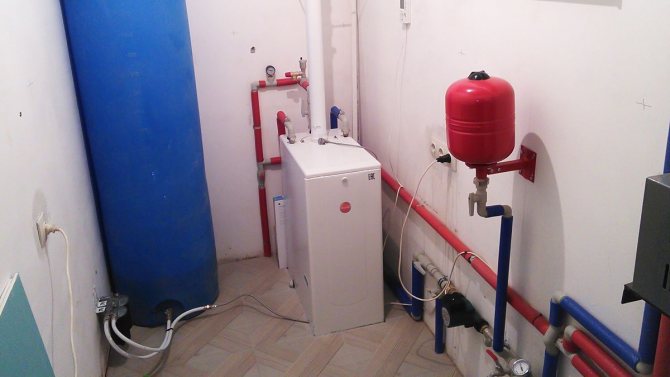
Diesel Kiturami Turbo and plastic fuel storage tank. The diesel is supplied by a fuel pump.
The main reasons for choosing boilers operating on diesel fuel are:
- lack of a gas pipeline in the place of residence;
- lack of desire in a constant fire with wood or coal, increased maintenance and cleaning of heating equipment, organization of storage of large volumes of solid fuel;
- availability of free access to diesel fuel or the ability to purchase it at a bargain price (from agricultural enterprises, tractor drivers, KAMAZ or bus drivers);
- small heated area, within 40-100 m2.
Even if there is a gas main in a residential area, the cost of connecting to it (permission, project, materials, etc.) is quite high. At the same time, the initial costs for organizing heating with a diesel boiler are minimal: a permit is not required, only a tank for storing diesel fuel is required (up to 0.8 m3 can be stored directly in the boiler room, when heating 100 sq. M. This volume is enough for almost the entire heating season).
Device and principle of operation
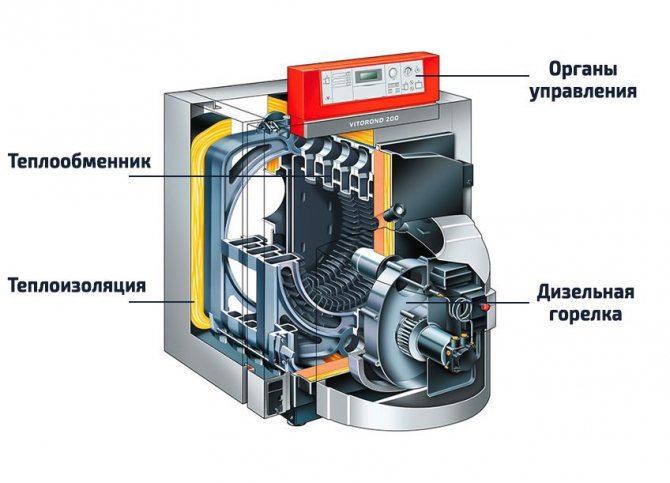

The device of diesel boilers using the example of Viessmann Vitorond 200
Diesel heating boilers differ from gas boilers only with a burner: it is equipped with a turbocharger, which provides the required pressure and atomizes fuel through the combustion chamber.
Also, diesel fuel requires preheating before spraying; special nozzles are used for spraying. Such a burner device implies a constant power supply, therefore boilers running on diesel fuel cannot be non-volatile. In domestic conditions with a high probability of power outages, it is recommended to additionally purchase a diesel generator.
In view of the differences only in the burner design, universal gas-diesel models are common, in which the conversion from gas to diesel and vice versa is carried out by simply changing the burner. Models with a replaceable burner are justified for the temporary use of diesel fuel, when it is planned to connect to the gas main in the future or if there is free, but not constant access to diesel fuel.
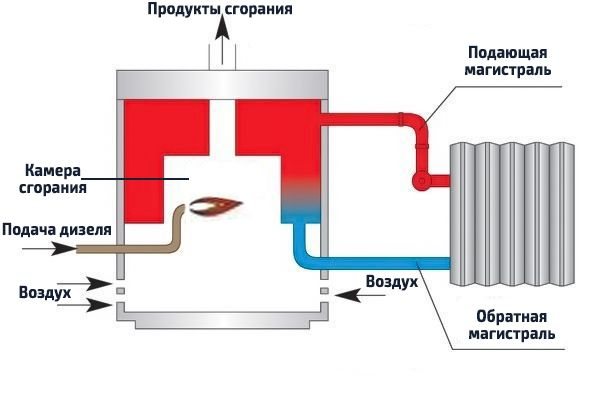

Otherwise, the principle of operation of household diesel boilers is standard:
- The fuel sprayed by the burner nozzles is ignited and burned.
- The walls of the combustion chamber are a heat exchanger with a coolant inside.
- The heat exchanger transfers heat energy to the heat carrier, which circulates naturally or forcibly (using a circulation pump) through the heating system.
Operation specifics
Burners of diesel heating boilers work quite noisy, even with a closed combustion chamber they fill the space with the smell of diesel fuel, therefore, a separate boiler room must be allocated for the operation of the boiler unit. The room requirements are the same as when installing a gas boiler, i.e. in accordance with SNiP 42-01 and MDS 41.2-2000, namely:
- ceiling height - at least 2.5 m with a room area of more than 4 m2;
- the presence of an openable window with an area of 0.03 m2 per cubic meter. meter of the volume of the room + structures with a fire resistance limit of at least REI 45, protecting the boiler room from the neighboring ones;
- there should be a free space of 1 meter in front of the boiler;
- doors with a width of at least 80 cm and a bottom gap of at least 2 cm;
- supply ventilation at the rate of at least 8 cm2 for each kW of boiler power, from neighboring rooms - at least 30 cm2 / kW.
- the boiler is connected to the mains with a separate three-core cable (usually included), through a separate RCD (the rating of which is always indicated in the boiler passport).
- the presence of a separate grounding bus in the boiler room, to which the boiler body is subsequently connected. In general, a diesel boiler is grounded in the same way as a gas boiler.
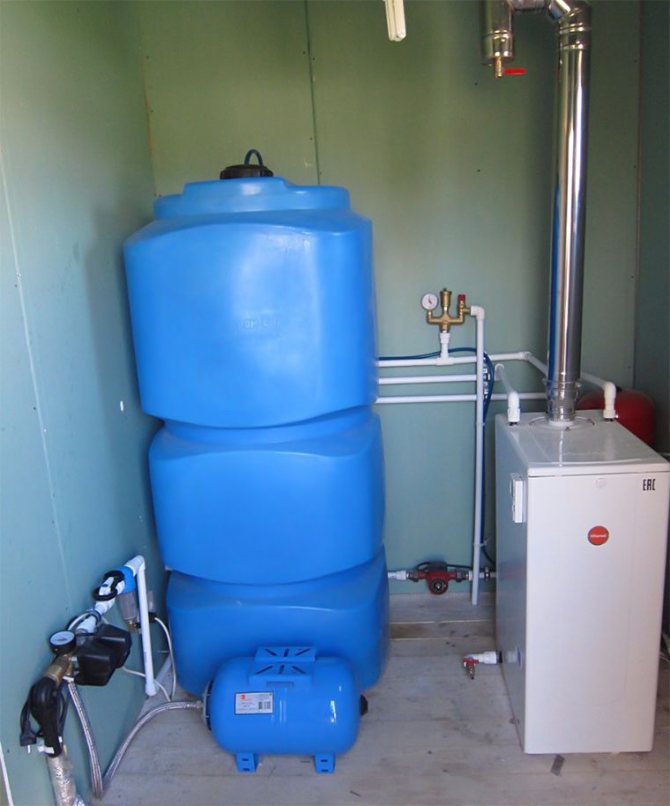

Organization of a boiler room with a fuel storage tank.
The fuel storage tank is also installed in the boiler room. With a volume of more than 0.8 m3, it must be taken out, but it should be borne in mind that the choice of diesel models is greatly narrowed: the boiler fuel pump must have an appropriate suction power. As a container, special tanks are used for storing diesel, usually made of strong plastic, resistant to aggressive liquids and external influences.
For external storage, 2 options are used: a set of plastic tanks connected by a pipeline or an underground plastic / metal tank (like a gas holder).
When storing above ground, it is imperative to insulate the tanks and the pipeline, since even at + 5 ° C the viscosity of diesel fuel increases, which complicates its transportation and increases the load on the fuel pump. It is not recommended to place containers in direct sunlight. You can also use frost-resistant diesel fuel, but the cost of using such fuel is simply unjustified.
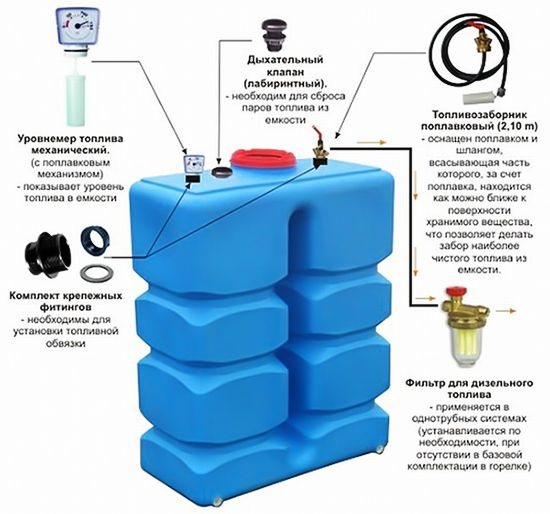

The most profitable and widespread storage option is underground, since the layer of earth provides a stable temperature both on hot days and in frost. In addition, the fire hazard of an underground tank is minimal, and the cost of the organization is often more profitable than in the above-ground version.
Most diesel boilers have a closed combustion chamber, so an inexpensive coaxial (side) chimney is sufficient to remove the combustion products, the diameter of which must match the boiler outlet. The only caveat is that the chimney must be placed at a slight angle in order to avoid the condensate formed in the chimney from getting back into the boiler.
Condensation is a natural process, the phenomenon is also called the dew point, its value is usually 7-10 degrees below the temperature of the flue gases (for example, at a smoke temperature of 85 ° C, dew point - 78 ° C). Therefore, during cooling in the outer part of the chimney, condensate, hazardous to the metal components of the boiler, forms.
In addition to placing the chimney at an inclination of 2-3 degrees, the formation can be prevented by insulating the outer part of the chimney. The formation of condensate is characteristic only of convection models; in condensing boilers, the temperature of the exhaust gases practically corresponds to the atmospheric one.
How to choose a room thermostat and save up to 30% per month on heating
The device and principle of operation of a diesel boiler
The design of units using liquid fuels as an energy carrier provides for the following main elements:
- Housings with built-in combustion chamber;
- A burner in which a combustible mixture is formed;
- One or two heat exchangers;
- Fuel pump;
- Filtration systems;
- Thermal sensors;
- Electronic control unit and settings.
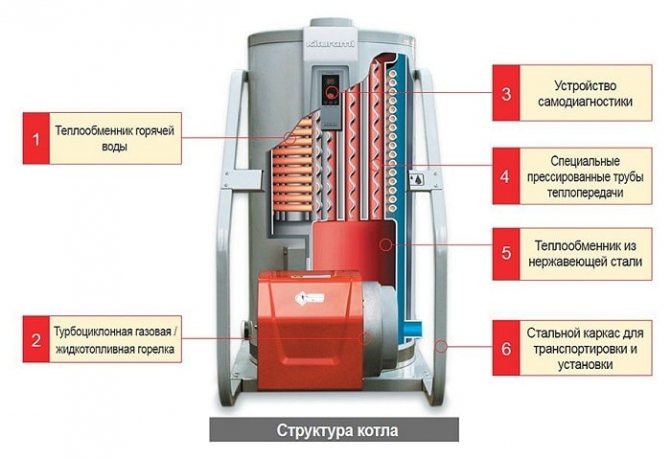

The material for the manufacture of heat exchangers can be steel or cast iron. Some premium diesel boilers are equipped with heat exchangers made of high-alloy heat-resistant steels.
Principle of operation
The fuel entering the burner is mixed with air, thus forming a fuel mixture, which is sprayed through the nozzle in the combustion chamber. The completeness of fuel combustion depends on the correct adjustment of the burner itself and the quality of the nozzle. The fuel mixture that has entered the combustion chamber is ignited by a spark generated by an automatic control system (ACS), and the heat released during the combustion process is transferred to the coolant through the walls of the heat exchanger.
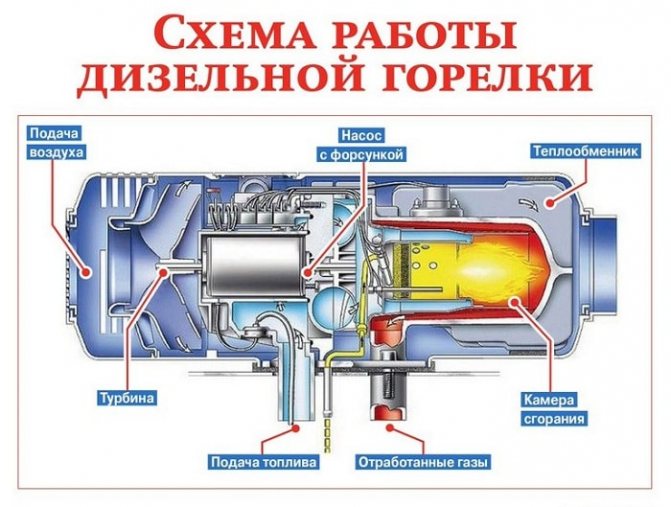

The coolant temperature is monitored by a system of temperature sensors installed in the combustion chamber. Upon reaching the set temperature mode, the ACS turns off the burner, and when the coolant is cooled, the combustible mixture is automatically ignited. The exhaust gases are discharged through the chimney.
Burners of diesel heating boilers can be fan and forced draft. In fan burners, overpressure is generated by a special built-in fan. The performance of such modules is quite high, but the operation of the units is accompanied by an increased noise level.
In forced draft burners, a turbine is installed instead of a fan. The use of turbocharging can significantly increase the productivity of the installation and achieve complete combustion of the combustible mixture. Exhaust gases can be removed from the combustion chamber both naturally, due to the draft generated in the chimney, and forcibly, using a fan.
Another design feature of a diesel fuel boiler for heating a private house is the possibility of changeover to work with other types of fuel, in particular, natural gas, for this you just need to replace the gas diesel burner.
Diesel fuel consumption
Specific heat of combustion 1 liter. diesel fuel - 10 300 kcal or 11.9 kW. This means that to obtain 1 kW of thermal energy, it is necessary to burn 0.084 liters. diesel fuel. It is also worth considering the efficiency, which, depending on the model, averages 90-95%, which means that about 5-10% of thermal energy is not transferred to the coolant.
Total, according to approximate calculations, calculations diesel boiler fuel consumption = Boiler power, kW / 10.
Often, the indicators are already indicated in the boiler passport. For example, the well-known budget Kiturami TURBO 13R (13 kW) with an efficiency of 86% consumes 1.97 kg / h or 2.25 l / h. However, this is only during continuous operation at full capacity. In practice, the boiler is on average active only 1/3 of the time, so the result can be safely reduced by 2-3 times.
For example, according to the owners of houses with an area of 100-120 m2, Kiturami TURBO 13R consumes from 5 to 7.5 liters of diesel fuel per day, depending on the degree of insulation of the house, temperature settings and the activity of using hot water.
Criteria for choosing a diesel heating boiler
When choosing a diesel heat generator, special attention should be paid to the following aspects:
Thermal power of a diesel boiler. In general, it is generally accepted that for effective heating of an area of 10 m2 in the middle lane, 1 kW / h of thermal energy is needed, in cold regions this figure can be 1.3 - 1.4 kW / h.
The ability to adjust the temperature. There are three main types of liquid fuel plants:
With a single-stage burner, operating constantly at maximum speed;
With a two-stage burner capable of operating in 50 and 100% modes:
With an adjustable burner that allows for a wide range of settings, which significantly reduces energy consumption.
Fuel consumption. It is this indicator that determines the economic feasibility of using a diesel installation, in addition, on the basis of these data, it is possible to prepare in advance the necessary fuel supply for the entire heating season.
In addition, one should take into account the possibility of creating a DHW circuit and reconfiguring the installation to use natural gas, in the case of supplying a centralized line.
Reviews of diesel fuel boilers: advantages and disadvantages
| Benefits | disadvantages |
| High autonomy - after starting, the boiler does not require any attention at all and is able to work for weeks, it is only necessary to provide the required amount of fuel | The high cost of fuel - when buying at a gas station or even at wholesale prices by ordering a fuel truck |
| High reliability - diesel engines have one of the highest service lives, on average 10-14 years (with a steel heat exchanger) and more (with a copper or cast iron) | All models are exclusively volatile - for the operation of the boiler, it is necessary to provide an uninterrupted power supply |
| High efficiency - on average 90-95%, although budget models still have indicators of 85-89% | Increased noise - the noise from the operation of the burner is noticeable not only during ignition, but also during operation |
| Fuel availability in any region of the country | The need for a separate room for the boiler room - not only because of the noise, but also because of the smell |
| Simpler and more budgetary installation process, no need for permission and project approval | Almost all models are floor-standing |
| Almost all models are equipped with protection against overheating and freezing, stopping the circulation pump |
Benefits of a diesel fuel boiler for your home
Diesel fuel boilers for heating systems and domestic hot water supply have a number of advantages that fully compensate for expensive diesel fuel. The most important advantages are the 85% efficiency and the ability to automate the combustion process. The user can independently install the DC at home without obtaining permits from the gas inspection and compulsory training with the passing of operating exams.
The main advantages of a diesel fuel boiler for home:
- fast execution of installation and construction works;
- affordable fuel supply even for remote areas;
- the prostate of arranging smoke through the wall of the building;
- automatic combustion mode in accordance with the outside air temperature;
- high level of protection, complete shutdown of the diesel heating boiler in the absence of water and flame breakage; acceptable prices.
However, this system also has disadvantages that can be technically eliminated, for example, noise during operation and the smell from diesel fuel, which is eliminated when placing diesel boiler plants in detached buildings. The next disadvantage of the DC is volatility, therefore, in regions with a low level of reliability of the power grid, the installation of a backup power source is required.
How much fuel does it consume per month
Fuel consumption for a diesel boiler for heating needs (RT) is related to the boiler power and is indicated in the passport. It can be obtained after dividing the power of the DC in kW by 10, the result is obtained in kg, the calculation is applicable for heating cold equipment during start-up.
In a stable operating mode, this figure corresponds to 30-50% and depends on the level of thermal insulation of the building. The required power (Mk) is proportional to the area in the ratio: 10 kW per 100 m2.
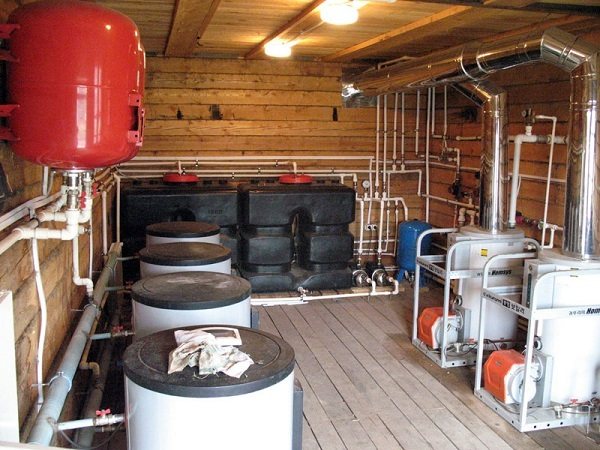

To determine the fuel consumption of a diesel boiler for a month or a season, simple calculations are performed:
Pt = Mk X 0.1. For a house area of 100 m2, the minimum power should be: 0.1X100 = 10 kW. Next, the hour is calculated: 0.1X10 = 1 kg of diesel fuel. Daily consumption: 1X24 = 24 kg.
It corresponds to the minimum outside air temperature in winter, which depends on the installation area and is specified in SNiP 23-01-99 "Construction climatology".
If the heating season is 200 days a year, for a preliminary calculation it can be assumed that the DC will work at full load for half of this period, and for half of this period, then the diesel fuel consumption for the entire season: (100X24) + (100X12) = 3600 kg. Consumption for the winter month with a minimum outside temperature: 100X24 = 240 kg. Consumption for the spring month: 100X12 = 120 kg.
These are average costs, they do not indicate a number of parameters: the degree of insulation, the estimated temperature inside the room, the load on hot water supply, the design of the heating unit.
How to choose a diesel heating boiler for a private house
Convection or condensing
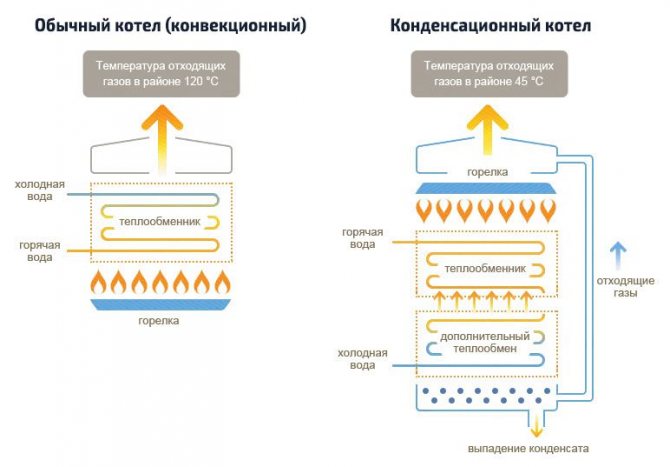

The principle of operation of conventional convection and condensing boilers.
The efficiency, and hence the economy, of a diesel heating boiler depends on the method of using the thermal energy released during the combustion of diesel fuel:
- convection - a standard type of boiler, in which the coolant is heated by direct combustion of fuel, while part of the heat goes away with the combustion products (the temperature of the flue gases is about 75-110 ° C);
- condensing - a modern boiler design, which implies the presence of an additional heat exchanger that extracts heat from the condensate, which in turn is formed from the combustion products discharged into the chimney. Thus, it is possible to accumulate practically all the heat obtained during combustion (the temperature of the flue gases is on average 35-45 ° C).
As a result, the efficiency of condensing boilers is 15-20% higher, however, the cost of such models is 1.5-3 times higher: as a rule, from 100 thousand rubles. Therefore, the payback of this technology depends on the amount of fuel burned.
Wall-mounted or floor-mounted
Due to the large dimensions of the burner and the greater weight of the boiler unit as a whole, diesel boilers, as a rule, are floor standing. There are also wall-mounted models, for example, the Swedish CTC 950 RU. However, at the moment, we do not recommend considering them for purchase: it is difficult to find them on sale, mounted models are 1.5-2 times more expensive than floor-standing counterparts, and the service structure is often not so developed even in Moscow and Moscow Oblast, not to mention the regions. ...
Single-circuit or double-circuit
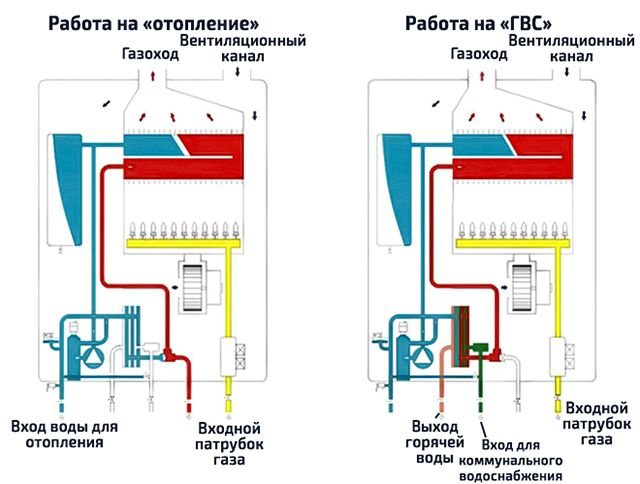

A clear principle of operation of double-circuit boilers with the priority of hot water supply (DHW).
Single-circuit models are designed exclusively for heating. Double-circuit ones have an additional hot water supply (DHW) circuit and when the tap is opened at the point of consumption, they begin to heat up sanitary hot water, which does not mix with technical hot water in the heating circuit. Of course, the choice depends on the requirements for the boiler.
At first glance, it is better to choose a single-circuit boiler, since the cost of fuel is already high. However, two-circuit models are still more effective, this is confirmed by the significantly greater demand for them. The cost of a double-circuit boiler of a budget and medium price category is only 5-15% higher, while organizing hot water supply in a house in a different way will need from 15 to 50 thousand rubles, and the cost of electricity, which will be spent on heating, is higher than the cost diesel fuel.
Heat exchanger material
The heat exchanger is a key element, not only efficiency, but also the durability of the boiler depends on the material of its manufacture, it is partially impossible to replace it, and a full-fledged element is expensive. So, a heat exchanger can be:
- steel - the most simple, lightweight and inexpensive to manufacture, installed on all budget and some models of the middle price segment. The steel heat exchanger is thin and most susceptible to corrosion, even with an anti-corrosion coating, it rarely serves more than 12-14 years.However, a steel heat exchanger is more resistant to temperature extremes and mechanical shock, heats up quickly (but also cools down quickly).
- copper - more expensive to manufacture, but more heat conductive and more resistant to corrosion. The service life of copper heat exchangers is up to 15-17 years (and more).
- cast iron - the heaviest and thickest, practically invulnerable to corrosion. Cast iron heat exchangers take a long time to heat up, but they also retain heat much longer, their service life is more than 25 years. In addition to severity, the disadvantage is vulnerability to temperature extremes and mechanical stress, in other words, the alloy is quite fragile (with the exception of expensive gray cast iron alloys).
How to choose a waste oil boiler for heating a private house
Open or closed combustion chamber
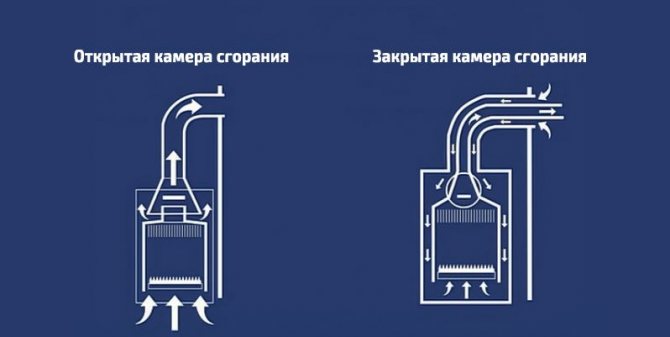

The type of combustion chamber determines the environmental friendliness of the boiler, the ventilation requirements and the choice of the chimney:
- open combustion chamber - classic and most common in gas and TT analogs, however, it is not always justified for diesel boilers. The air required for fuel combustion in an open combustion chamber is taken from the room through openings in the boiler body, and the exhaust is discharged through a classic vertical chimney. This means that in addition to organizing a more complex chimney, high-quality ventilation of the room is necessary, it is also worth mentioning that soot formation and contamination of a boiler with an open combustion chamber is higher.
- closed combustion chamber - most models are equipped with it. For the organization of work, a simpler and more budgetary coaxial chimney is enough. Air intake takes place through the inner chimney pipe, and the exhaust goes through the outer one. With this principle of operation, the room is less polluted, although the smell of diesel fuel is still present.
Efficiency
The coefficient of performance (COP) is the ratio of the volume of consumed fuel to the volume of heat released and accumulated by the coolant, i.e. the efficiency of the heating boiler. If for gas or solid fuel boilers efficiency is not the most important indicator, then for diesel boilers, in view of the high cost of each extra liter of fuel, this is a weighty selection criterion.
As mentioned earlier, the average is 90-95%. Nevertheless, there are excellent models from well-known manufacturers Kiturami and Navien with an efficiency of 86-89%. Despite their lower efficiency, they have an extremely low initial cost, are known for reliability and ease of maintenance, have a developed service structure and readily available spare parts.
It makes no sense to consider models with an efficiency below 86%, otherwise, due to inefficient energy conversion, the cost of their operation will be comparable to electric boilers.
Minimum required power
For a standard non-insulated house with 2 bricks masonry and a ceiling height of 2.7 m, located in the climatic zone of the Moscow region, the required power is calculated quite simply: 1 kW for every 10 m2 of heated area. We also recommend setting the power reserve at 15-20%.
For example, for a house with an area of 150 m2, the minimum required power of a diesel boiler = 150: 10 * 1 * 20% = 18 kW. Please note that it is also undesirable to overdo it with power, the boiler will cycle too often, which will lead to faster wear.
How to accurately calculate the required boiler power Individual calculation, formula and correction factors
Additional criteria
Having decided on the main criteria, you can turn to such features as:
- the presence of heat and sound insulation - an additional layer of thermal insulation reduces heat loss through the boiler body itself and increases efficiency, and sound insulation will eliminate the noisy operation of the burner, which is especially important if there are thin walls between the boiler room and the living room;
- automation functionality - the presence of autodiagnostics, heating modes, the possibility of programming work for a day or a week in advance, the presence or ability to connect an external thermostat, weather-dependent control.
Advantages and disadvantages of diesel boilers
Like any other equipment, diesel boilers have their own strengths and weaknesses. The advantages of such units include:
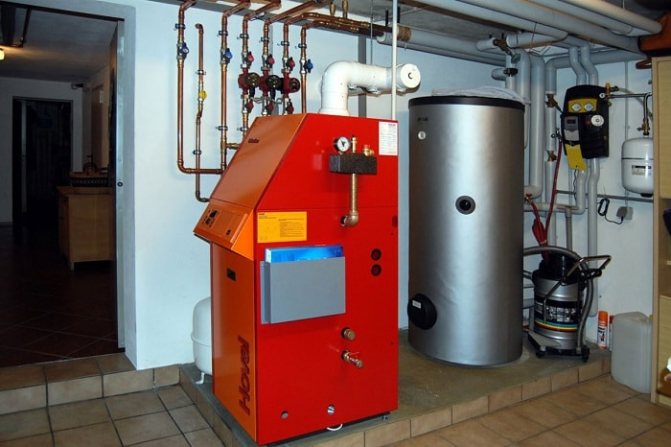

- The device is fully automated and can function autonomously without operator intervention. The duration of continuous operation is solely due to the capacity of the fuel tank.
- With proper operation of the automation, boiling of the coolant is almost impossible, since the power of the installation can be instantly reduced to a minimum by turning off the fuel supply.
- When stored, liquid fuel takes up much less space than a supply of coal, firewood or pellets.
- Possibility of using waste oil and other liquid combustible waste as an energy carrier.
- Unlike gas boilers for heating a private house, the installation of diesel heating equipment does not require coordination with the relevant services and can be done on its own.
Along with these indisputable advantages, significant disadvantages should be noted:
- Since the operation of a diesel boiler without an automatic control system is impossible, it is necessary to ensure uninterrupted power supply to the installation. Despite the fact that electricity consumption is minimal, this still creates certain difficulties.
- The cost of standard diesel fuel for heating systems is significantly higher than the cost of wood and coal.
- To avoid fuel thickening at low temperatures, pipelines need high-quality thermal insulation.
- When storing fuel in an underground tank, in the event of a leak, soil and groundwater poisoning may occur.
- The need to create a boiler room, since the operation of a diesel installation is associated with an increased noise level and the possibility of unpleasant odors.
- Regular delivery of fuel and the organization of a special storage facility is required.
Despite the above disadvantages, diesel boilers are most widely used in summer cottages and private houses due to the possibility of autonomous operation, high efficiency and ease of installation.
The best known manufacturers and models: characteristics and prices
Kiturami Turbo 13R
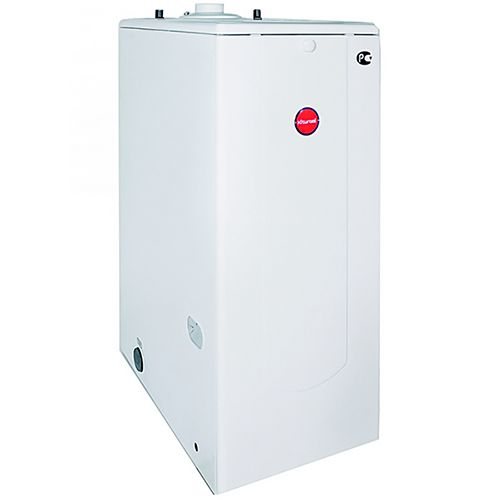

The most common and time-tested Korean double-circuit diesel boiler with a capacity of 13 kW (there are versions of other capacities). Since the boiler is in the budget price category, its heat exchanger is steel, although the secondary (for hot water supply) is copper. Despite the efficiency of 86% and the consumption of up to 1.97 kg / h (2.25 l / h), the model is popular due to its reliability, wide automation functionality and affordable price, one of the lowest on the market.
The main advantage is the presence of a room thermostat in the factory configuration, with the help of which it is possible to more accurately and conveniently regulate the temperature regime (which also affects the efficiency). Also, the automation has various heating modes, self-diagnostics, overheating protection and an anti-freeze mode.
The cost: RUB 29,000-33,500
Navien LST-17KG
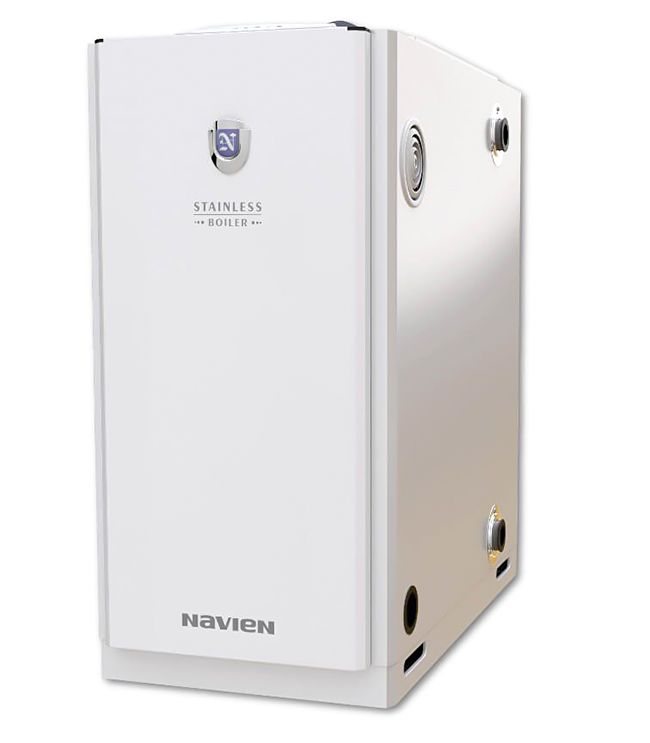

Another common Korean double-circuit boiler for diesel fuel with a capacity of 17 kW. Equipped with a steel heat exchanger. It has a higher efficiency of 90% and a lower flow rate - 1.93 kg / h (2.2 l / h). The model is still equipped with a remote control via a room thermostat. A significant advantage is the ability to program the operation of the boiler, which can significantly reduce fuel consumption, for example, by programming a temperature drop to 15 ° C during the absence of the owners at home (work, rest, travel).
According to the reviews of the owners and the installation practice, for more than 6 years of operation of these models, almost no single malfunction was observed.
The cost: 33,200-35,000 rubles.
De Dietrich EFU 22 (B-Control)
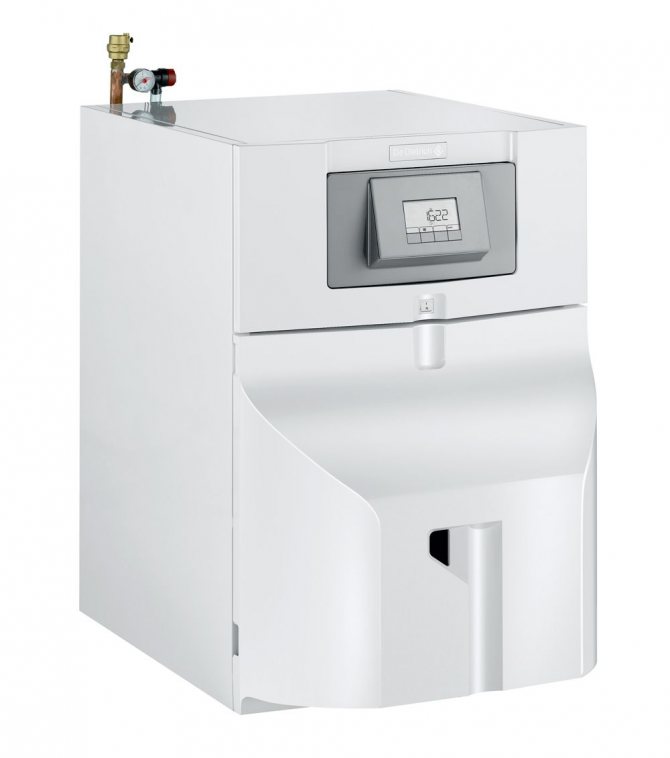

One of the best diesel boilers for heating a private house, especially with an area of more than 200 m2. This is a 22 kW French low temperature single circuit model. It features a durable cast-iron heat exchanger and high efficiency - up to 97.3%. The boiler complies with the highest environmental standards, in practice it works almost silently (thanks to a heat exchanger with three-way gas removal and sound insulation). Has functional controls, auto ignition, the ability to connect an external thermostat (it is not included in the kit). The only drawbacks are its heavy weight (185 kg) and high cost.
Please note that the boiler has an open combustion chamber and an atmospheric burner, therefore it needs natural ventilation through a classic vertical chimney.
The cost: 116,000-135,000 rubles.
Ferroli ATLAS 32
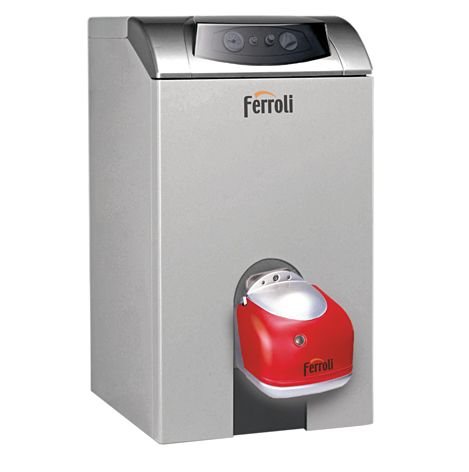

Universal Italian single-circuit model with replaceable burner (diesel - burner SUN G, gas - SUN M) with a capacity of 32 kW. It features high reliability and efficiency up to 94.3%, as well as a durable cast-iron heat exchanger. There is protection against overheating and freezing, it is possible to connect an external thermostat. The boiler works almost silently, but has an open combustion chamber. There were no obvious shortcomings in the experience of installation and operation.
The cost: 53,500-61,000 rubles. + Ferroli SUN G burner - 25-29 thousand rubles.
Lamborghini AX 3 32
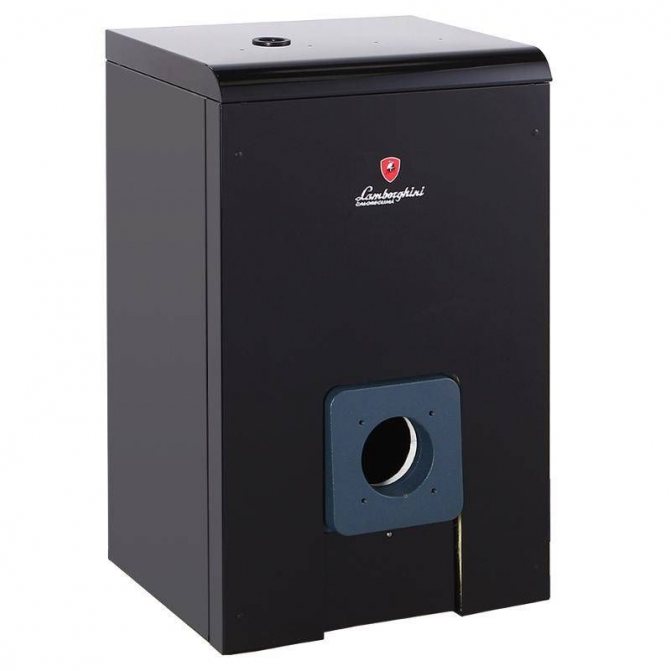

Another Italian universal single-circuit boiler with a replaceable burner (gas-diesel) with a capacity of 32 kW. It practically does not differ from the previous analogue, it is equipped with the same cast-iron heat exchanger with a three-way exhaust of gases, is known for its reliability, has a stylish design. However, it has a lower efficiency of 91.6% and more limited functionality (external control connection is possible). There is a layer of thermal insulation under the body, and the ease of operation and maintenance can also be noted.
The cost: 51-65 thousand rubles + Lamborghini Fire 3 burner - 22 600-27 000 rubles.
Selection criteria for a private house
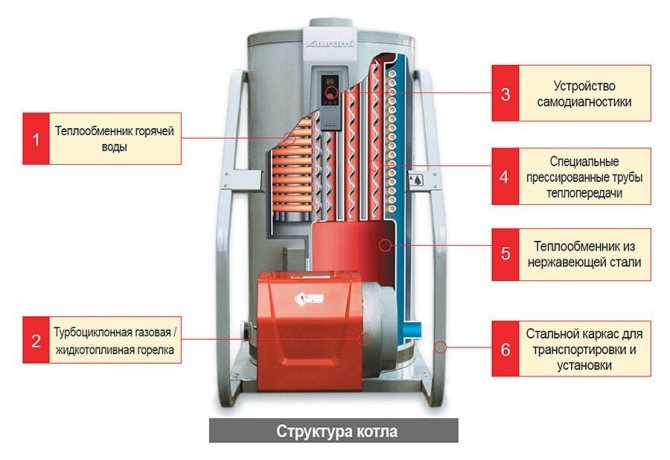

Internal structure of a diesel boiler
The range of diesel heating boilers is large, so choosing the most suitable model is not easy. They are based on the following criteria: number of circuits, method of installation and removal of exhaust gases, power, type of fuel and cost.
If the heating system must only heat the house, it is enough to purchase a single-circuit type. If you need to heat the premises and use hot water, it is better to give preference to double-circuit heating equipment.
The power is calculated depending on the area of the heated room. When making calculations, it is important to take into account all heat conductors - wall material, floors, windows and doors. For help, you can turn to engineers or use special calculators.
Diesel boilers on the market are divided into three main price groups: cheap - Russian-made; average in price, but with good quality - made in Slovakia, Japan, Czech Republic, Spain, South Korea and Italy; expensive and high quality - made in Germany, Sweden.
Prices: summary table
| Model | power, kWt | Number of contours | Efficiency,% | price, rub. |
| Kiturami Turbo 13R | 13 | double-circuit | 86 | 29 000 |
| Navien LST-17KG | 17 | double-circuit | 90 | 33 000 |
| De Dietrich EFU 22 (B-Control) | 22 | single-circuit | 97,3 | 116 000 |
| Ferroli ATLAS 32 | 32 | single-circuit | 94,3 | 80 000 |
| Lamborghini AX 3 32 | 32 | single-circuit | 91,6 | 74 000 |
Fuel storage
An important issue when purchasing diesel equipment for home heating is the way of storing fuel. There are two options available.
The first involves storing flammable liquid inside the boiler room. Moreover, the maximum volume that is allowed for storage is 800 liters. This is not enough, it will not be enough for the entire heating season, especially for regions with a long period of cold weather.
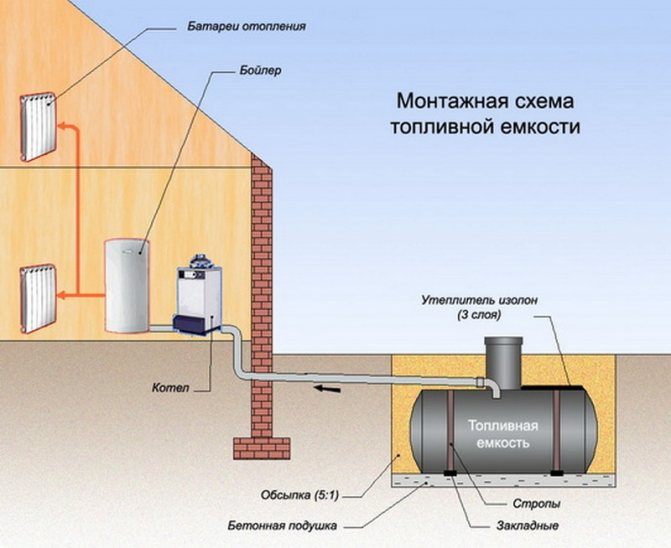

Fuel tank wiring diagram
Therefore, the second option for storing fuel using an external container (4-10 tons) is still preferable. It is installed on the surface or dug into the ground. It is best to place it at a depth where the layer of earth does not freeze so that the diesel fuel does not thicken from low ambient temperatures. Additionally, the container is insulated, as well as the pipeline for supplying fuel to the furnace.
It is preferable to choose stainless steel fuel tanks.
When there is no opportunity to conduct gas communications for heating a country house, a diesel boiler can be a good alternative. Heating a private house with diesel fuel costs a lot, but it is much more economical than the option using electrical equipment.
Installation and connection
The process of installing diesel boilers does not differ from gas or solid fuel counterparts and is carried out in accordance with SNiP 41-01-2003 "Heating, ventilation and air conditioning" and SP 7.13130.2009 "Heating, ventilation and air conditioning. Fire safety requirements ". Works are carried out at a temperature not lower than + 5 ° C.
The boiler piping also does not differ from that used for the installation of analogs, an example of a classic connection diagram to a closed-type system is shown in the photo below.
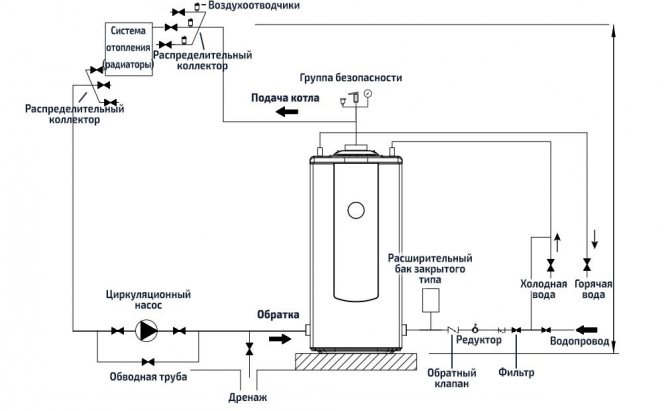

Diagram of connecting a diesel boiler to a closed heating system.
All overall and connection dimensions as well as a detailed installation algorithm are always described in the boiler operating instructions, today an electronic copy of the instructions for any of the models can be found on the Internet. Please note that installation, adjustment and the first start-up must be carried out by a certified specialist who will put the appropriate stamp in the boiler passport: without it, most manufacturers refuse warranty obligations.
Fuel storage
Diesel heating requires the organization of a tank for storing fuel and supplying it to the equipment. The place for its placement is determined for fire safety reasons. There must also be a convenient driveway to fill the tank.
Note: According to the established standards, a container with fuel no more than 0.8 m3 can be placed in the boiler room. This volume will not be enough, therefore a fuel storage is required. According to the norms, the volume of such a container should not exceed 20 thousand liters.
To organize a place for the fuel storage, you can dig a pit, the bottom of which is covered with a cement-sand cushion. This layer is about 20 cm. This distance should remain between the walls of the container and the walls of the pit. The pit is filled up with a cement-sandy composition. Compaction must be done every 20 cm, water must be added.
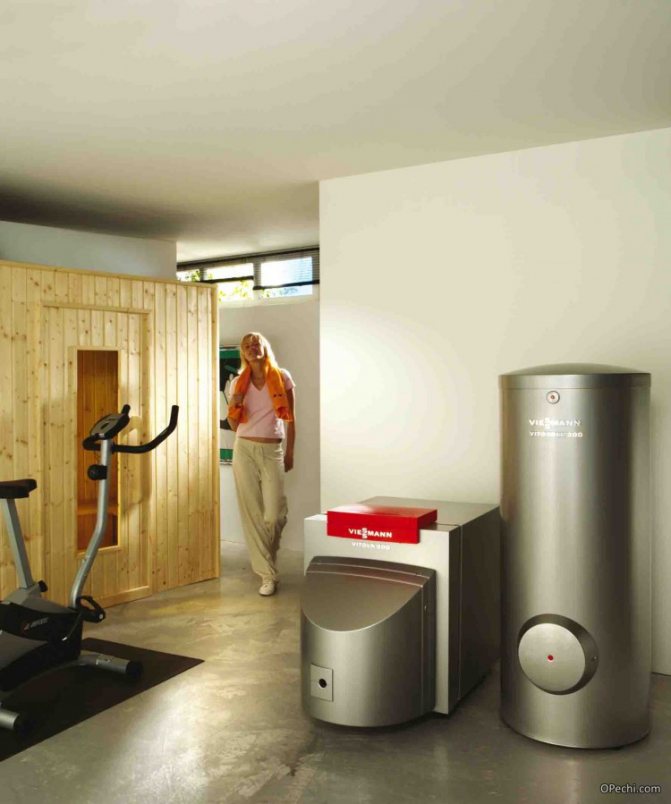

Fuel storage and diesel boiler
You should not save on tanks for heating equipment. If you make it yourself, cracks can occur, the result of which will be fuel leakage, which means high costs. Therefore, it is recommended to use certified containers.
You can use more than one diesel tank, but several, tying them with a special strapping. Nowadays, tanks made of polyethylene lined with steel sheet are very popular. You can also use a glass reinforced plastic container.
If the diesel boiler is below the level of the tank location, then a gravity fuel supply system can be used. If the level is the same or the container is slightly higher than the burner of the diesel stove, the burner pump is able to suck in diesel on its own. If the level difference is more than 5 meters, additional help is needed.
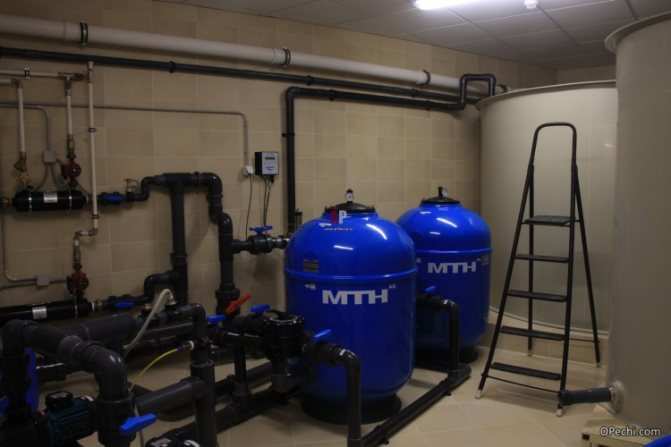

Fuel storages of the heating system with the participation of a diesel boiler
If there is a rather large distance between the tank and the boiler, the fuel line runs outside, it should be deepened into the ground by 1.5 meters. This is necessary to prevent freezing.
Maintenance
A feature of boiler equipment using any fuel is the formation of soot inside the combustion chamber and chimney, the formation of scale inside the heat exchanger, clogging of the nozzles and the fuel filter, all this not only reduces the efficiency by 25-30%, but can also lead to more serious malfunctions.Therefore, regular maintenance consists exclusively of inspection and cleaning, it can be carried out not only upon the call of specialists, but also by yourself, while the guarantee remains relevant.
Regularity - at least once every 3-5 years, we recommend cleaning the boiler once every 1-2 heating seasons and flushing the heat exchanger every 4 years.
- Cleaning and flushing the heat exchanger... When hard untreated water is used as a heat carrier, scale and other salt deposits form on the inner walls of the heat exchanger, which reduce its cross section and thermal conductivity. It can be cleaned mechanically, using a solution of citric or hydrochloric acid, or without removing it from the boiler, by hydrodynamic flushing. We have already described the detailed algorithm for cleaning the heat exchanger earlier, it is the same for boilers using any fuel.

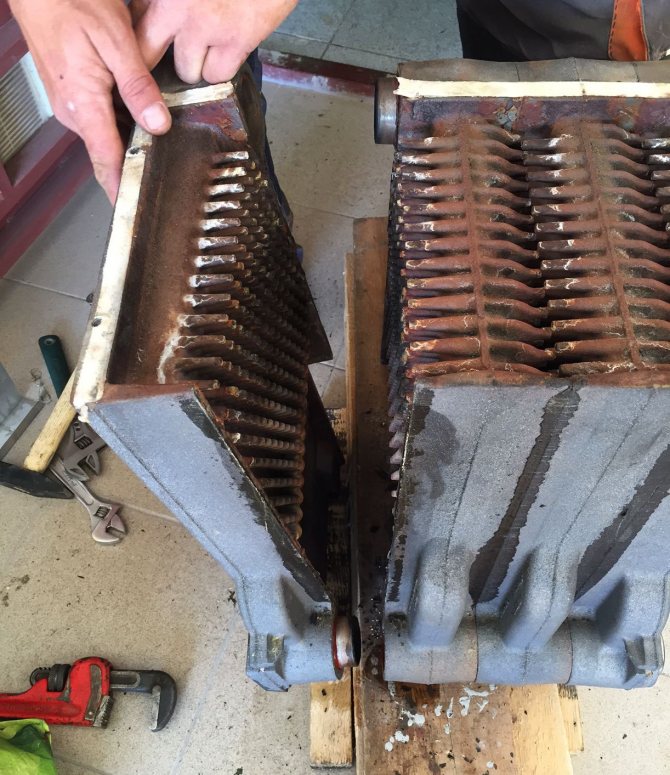
Soot and rust inside the cast iron heat exchanger sections. - Cleaning the burner, combustion chamber and outer walls of the heat exchanger... During operation, soot forms on these elements, debris and dust from the room are retained, a layer of at least 0.5 cm reduces the efficiency by more than 10%. The cleaning process also does not differ from analogs, with the exception of a different burner design (we also described it earlier).
- Cleaning or replacing the fuel filter... The fuel filter is not installed in many models of diesel boilers, but it is an extremely important component, since both the degree of soot formation and the service life of the boiler depend on the quality of fuel cleaning. And given the quality of domestic diesel fuel, a fine and even coarse filter, their regular cleaning or replacement is just a necessity.
The most common consequences of a lack of regular maintenance are:
- Parasite flame... The logic is to receive a signal from the ionization sensor about combustion before the board gives a signal to open the fuel valve / injectors. To solve the problem, it is enough to clean all components of the burner. Rarely fluid spills onto the electronic control board.
- The boiler is smoking heavily... The classic consequence of clogged injectors: due to the lack of a fuel filter or during the process of soot formation. In open chambers, clogging can also occur due to dustiness in the room or repair work. To solve the problem, it is enough to remove the burner, carefully clean and blow out the nozzles.

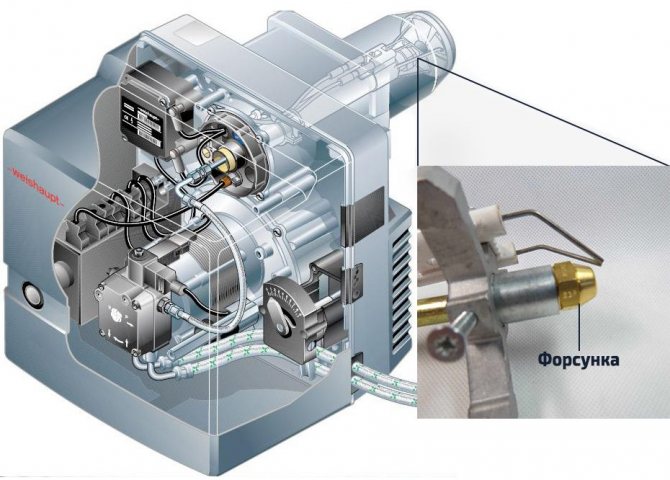
The location of the nozzle in the diesel burner.
Installation rules
It is best to call specialists to install the equipment, who will make the connection professionally. However, the installation of a diesel heating boiler can be done independently. Its installation does not require a mandatory special permit, as is the case with gas equipment. But there are separate requirements for the installation, as well as the arrangement of the combustion room:
- A separate building must be provided for the installation of the heating boiler. If this is not possible, at least a separate technical room, for example, in the basement of a house. The main condition for this is that there must be a separate exit to the outside.
- The ceilings in the equipment room are provided for at least 2.5 m.
- The volume of a technical room or a separate building should not be less than 15 m².
- Experts strongly recommend the installation of fuel cleaning filters to extend the life of the equipment.
- For boilers with a capacity of 350 kV, a separate power line should be installed from the general machine.
- It is recommended to install it away from doors and windows.
- Facing the walls of the furnace with non-combustible finishing materials.
Oil heating boiler
In addition to diesel fuel, domestic or Korean-made liquid fuel boilers can operate on waste oil, fuel oil, kerosene or biofuel.The main element of such equipment is a nozzle, which is used to mix fuel with oxygen and supply the mixture to the boiler combustion chamber. Despite the fact that this type of heating can be combined with infrared heating of the room through the underfloor heating system, the units under consideration have other advantages:
- full autonomy;
- the possibility of automatic control of the boiler.
The main disadvantages of liquid fuel units are considered to be the release of an unpleasant odor during fuel combustion, the need for special storage equipment and proper installation of the boiler. Incorrect installation of the unit can lead to malfunctions of the entire heating system, so many users order turnkey heating from professionals. If there is such a need, leave a request on our website, or call + 7-926-966-78-68
| Work performed | Price |
| Installation of a floor-standing boiler for liquid and solid fuels | from 18,000 rubles. |
| Installation of an indirect heating boiler | from 12,000 rubles. |
| Installation of the boiler safety group | from 1100 rub. |
| Circulation pump installation | from 1400 rub. |
| Expansion tank installation | from 1400 rub. |
| Installation of the main mix collector | from 1500 rub. |
| Installation of the thermohydraulic manifold | from 1700 rub. |
| Installation of the pumping group | from 2000 rub. |
| Installation of a radiator, floor convector, etc. | from 1800 rub. |
| Installation of the floor convector | from 2500 rub. |
| Installation of a collector with underfloor heating flow meters | from 2500 rub. |
| Installation of risers made of polypropylene, polyethylene, metal-plastic | from 800 rubles / running meter |
| Layout of heating pipes to radiators | from 2500 rub. |
| Heating system pressure testing | from 4000 rub. |
Installation of a diesel heating system
The organization of diesel heating at home is a rather laborious and complicated process. To do it yourself, you should take into account some of its features. In addition to preliminary accurate calculations, it is important to know the sequence of work:
- Heating boiler installation;
- Laying of piping and hot water supply;
- Connecting heating devices;
- Installation of shut-off valves, pump and expansion tank;
- Installation of an automatic control system;
- Test run of the heating system.
It is possible to minimize the occurrence of errors by strictly following the work process and recommendations set by the heating equipment manufacturer.
In general, diesel heating in a private house is an efficient and reliable way to heat real estate. The process itself is fully automated, so it does not require constant monitoring of its work. If you are ready to spend a considerable amount of money, then this option is optimal in the absence of access to natural gas.
Calculation of heating radiators
Each room will need a heating radiator. Its size is determined at the rate of 100 W per 1 m2 of the room area.
Since various types of radiators differ noticeably in power, we will select them when buying, but in order to get our bearings in advance, let's estimate:
A "classic" cast-iron radiator has a thermal output of one section of about 150 W, that is, in a room three by five meters, a radiator of 15 m2 will be required (we do not take into account the power of the boiler, but the heat consumption for heating the building) 100 W: 150 W / section = 10 sections.
For aluminum with its output of 200 W, 7.5 sections are required. Rounding up, we get 8.

